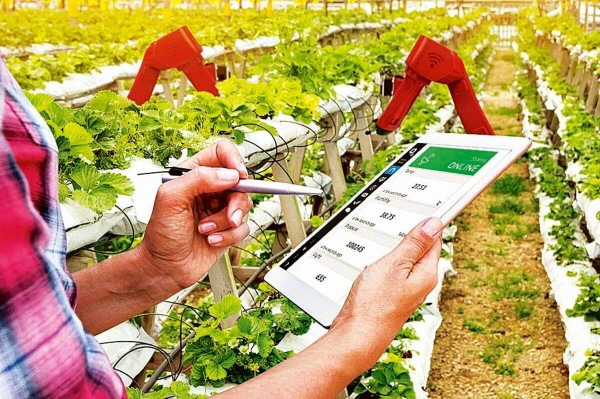Increasing farmer income has been the focus of Indian Agriculture. India is a world leader in production of milk, pulses and jute, and ranks as the second largest producer of rice, wheat, sugarcane, groundnut, vegetables, fruit and cotton.
Increasing income through digital technologies has been realized as an opportunity for farmers, industry and the government. It can increase the efficiency of the agricultural production processes as well as the entire value chain. The use of digital technologies in a variety of fields, are being developed including networks of IoT implements and data-generating sensors, image recognition to assay and grade crops and commodities and AI applications.

Implementing digital agriculture for an Indian small farm and then scaling up and making it available to farms in a region or agro-climatic zone will be a success by implementing the following measures:
Low-cost Technology: At the all-India level, an average monthly income per agricultural household during agricultural year 2018-19 was INR 10,218. Therefore, locally developed low-cost technology will be a most attractive solution.
Portable Hardware: The Indian market is ripe for plug-and-play hardware, since most farms are small. Also, leasing of agricultural land is a common practice under various farming arrangements, so a farmer may move from one plot of land to another over cropping seasons. Therefore, farmers are better off investing in mobile equipment under such circumstances.
Aggregation, rental, and sharing platforms of agricultural machinery and equipment: A lack of financial resources and small farm plots make renting and sharing equipment an attractive alternative to outright purchases, making digital platforms with equipment rental and sharing services a basic requirement in the process.
There is a significant potential for Digital Agriculture across the entire agriculture value chain from the upstream (inputs and production processes) to the downstream (post-harvest and value addition including food processing) with the establishment of FPOs (Farmers Producer Organization) in India. It is in these FPOs that farmers, their production, and marketing of their products are consolidated. FPOs are ideal for promoting the adoption of precision agriculture and smart agriculture, that is, the full spectrum of technologies under Digital Agriculture, because they offer larger land parcels that can be leveraged for technology roll out. The FPO also provides affordable and accessible technology for even small farmers, ensuring a win-win outcome for all stakeholders.
In addition to acting as an aggregator of inputs and output, FPO facilitates economies of scale for member farmers and strengthens their bargaining power. They can facilitate sales through e-trading depending on the regional and national demands and requirements.
Imagery taken from satellites
In crop production, equipment designed to use satellite imagery for variable seeding rates and depths is generating less waste and higher yields.
With the use of drones and digital sensors, infrared light and heat can be measured and used to make decisions about the health of paddock crops. It can help in taking informed decisions by sending appropriate information about Irrigation, Pest control, Uses of fertilizers and the harvest.
Sensing devices and electronic identification
Integrated biometric sensors and electronic identification devices improve the health and performance of livestock, as well as help farmers identify cases of stress or disease in real time.
Support from academic institutions and farmer support organizations – People involved in Local programs and government initiatives are consistently in touch with farmers. Farmer adoption of digital technologies can be improved by training farmers by them, or by academic institutions and agricultural organizations.
Benefits of Digital Agriculture
Through the implementation of the above solutions, farms can be managed and monitored effectively. As farmers gain a complete digital analysis of farms in real-time, they are able to take logical decisions for using pesticides, fertilizers, and water consumption judiciously.
Other benefits include: –
- Reducing production costs and increasing agriculture productivity
- Prevent soil degradation
- Using fewer chemicals in crop production
- Increasing water efficiency and effectiveness
- Boosting farmers’ income and status
- Minimizing environmental damage
- Enhancing worker safety
There are also a number of new and emerging technologies that can boost agricultural productivity, such as:
- Robotics
- Technologies for measuring data based on biotechnology, digital and wireless technology
- Monitoring the weather
- Monitoring animal health
- Monitoring geospatial environment
- Applications of Water and chemicals with precision
Agritech companies can play a vital role in supplying farmers with advanced technologies such as IoT, Artificial Intelligence/Machine Learning, and agri-drones for unmanned aerial surveying, as the Indian Agriculture and Allied sector is showing keen interest in the adoption of modern technology. It is however likely that technology affordability, easy maintenance of systems, supportive government policies, ease of access, and operation will determine the success of digital agriculture in India. To achieve objectives, such as doubling farmer incomes and promoting sustainable development, a holistic ecosystem approach is of national interest in the Indian agriculture sector. Thus, digital agriculture in India will need a multi-stakeholder approach with the government playing a key enabler.

